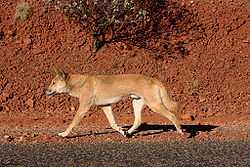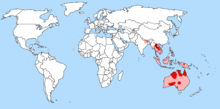Canis lupus dingo
| Dingo | |
|---|---|
 | |
| Australian dingo | |
| Conservation status | |
| Scientific classification | |
| Kingdom: | Animalia |
| Phylum: | Chordata |
| Class: | Mammalia |
| Order: | Carnivora |
| Family: | Canidae |
| Genus: | Canis |
| Species: | C. lupus |
| Subspecies: | C. lupus dingo |
| Trinomial name | |
| Canis lupus dingo (Meyer, 1793) | |
 | |
| Dingo range | |
| Synonyms[2] | |
|
antarcticus (Kerr, 1792), Canis australasiae (Desmarest, 1820), Canis australiae (Gray, 1826), Canis dingoides (Matschie, 1915), Canis macdonnellensis (Matschie, 1915), Canis novaehollandiae (Voigt, 1831), Canis papuensis (Ramsay, 1879), Canis tenggerana (Kohlbrugge, 1896), Canis harappensis (Prashad, 1936) Canis hallstromi (Troughton, 1957) | |
The taxon Canis lupus dingo is named for its most famous and original member, the Australian Dingo, but it also includes non-Australian animals such as the New Guinea Singing Dog, the Thai Dog, and other animals which are considered taxonomically identical to the Australian Dingo, so any differences would be at the level of "variety," "landrace", or "breed". The name indicates that, like the familiar common dog, Canis lupus familiaris, it is one of many subspecies of Canis lupus, the gray wolf. While current taxonomy lists it as "provisionally separate" from C. l. familiaris, the current taxonomy notes that it is legitimate to view the two as united into one subspecies, the "domestic dog", while admitting that this "stretches the subspecies concept."[3][4]
Origin
Dingoes may have evolved in the northern areas of Thailand and Vietnam between five and six thousand years ago from south Asian wolves quite similar to the Indian Wolf and the Arabian Wolf. The early evolutionary process was one of domestication; a process which has both biological and anthropological elements. Wild wolves and human cultures evolved a commensal relationship in which each derived benefits from learning to tolerate or interact with each other, a process that transformed the physical features and instincts of those populations of wolves living around human settlements from wolf into dingoes, generally considered to be a subspecies of Canis lupus intermediate between wolf and dog.[5]
Taxonomic synonyms
Current taxonomy identifies nine taxonomic synonyms for the term Canis lupus dingo, the majority of which referred to the Australian Dingo but several of which refer to animals found in Southern and Southeast Asia.
"harappensis", an ancient dingo found in South Asia
During excavation seasons in 1924-25 and 1930–31, a team of researchers at Harappa, in modern Pakistan, collected a wide variety of ancient domestic animal remains which had been buried since three thousand years BC. The remains included a dog which the researcher who wrote the report named the Canis tenggeranas harappensis, noting "marked skull affinities to the Indian Wolf" and hypothesized to be the ancestor of the Indian Greyhound.[6] Since that time, however, mammalogists reviewing the evidence have concluded that it is taxonomically identical to the Australian Yellow Dingo and have therefore grouped it together with the Australian Dingo into the taxon Canis lupus dingo.
"tenggerana", the dingoes of Java
In the late nineteenth century, experts working in the Tennger Mountains in Eastern Java identified a dog living there which they named "Canis familiaris tenggerana". They observed the dogs living alongside the natives in a semi-domesticated state.[7] Since that time, Canis familiaris tenggerana has been identified and reclassified as C. l. dingo.
"papuensis"
In a report to the Linnean Society of New South Wales in 1882, N. De Miklouho-Maclay identified several anatomical and behavioural differences between Australian Dingoes and dogs that inhabited the coastal lowlands(Maclay Coast) of Papua New Guinea. He gave the Papuan coastal canines the scientific name Canis papuensis. The differences between Canis dingo and Canis papuensis included a much smaller brain, which he attributed to the quite different lifestyles of the two animals. There were several differences in overall looks and build. In fact, the dogs he dubbed Papuan Dogs or New Guinea Dogs bore little resemblance to the canines commonly known as New Guinea Singing Dogs. Whereas the Australian Dingo is well known for its intelligence and boldness, as well as near independence from humans, he reported that the coastal Papuan canines remained on the periphery of native villages, regularly feeding on cast-offs and human waste. Hunting on their own was almost unknown. Instead of the bold independence of the Australian Dingo, the coastal dogs behaved very subserviently toward humans, exhibiting begging and grovelling. Additionally, he stated, "The Canis papuensis is very different in appearance and character from Canis dingo; is generally smaller, has not the bushy tail of the dingo...." Since New Guinea Singing Dogs or New Guinea Dingoes were not mentioned in his report, it is unknown whether Miklouho-Maclay was even aware of their existence. His report was only concerned with canines he observed along the Maclay Coast.[8]
Other Dingoes
Dingoes without recognized taxonomic synonyms have also been identified.
Dingoes of Peninsular Southeast Asia
Pure Asian dingoes live freely in many areas of Southeast Asia.
The most common variety is the "Thai Dog", sometimes called the "Thai Dingo", which are also found in neighboring countries. They tend to be somewhat smaller than Australian Dingoes, and live and behave less like wild animals. Although many are kept as pets or working dogs, the majority roam freely and subsist by begging and scavenging from humans. Many Thai people believe that as Buddhists they gain merit by leaving food out for the free-roaming "neighborhood dogs" in the streets. Consequently, Thailand has a large population of wild dogs and also many of the attendant problems having such a population entails, such as periodic rabies epidemics.
Extensive morphological and genetic testing has supported the observations of Australian Dingo experts that Thai Dogs are taxonomically identical to the Dingoes in Australia. However there are a few noticeable differences. Black and ginger color variations, rare in Australia, are common in Thailand and Thai Dogs tend to have shorter hair. Their behavior is also substantially different; they live among and alongside people as urban free-ranging dogs. As such, they are viewed as unexceptional mongrel dogs, and not, as in Australia, as wild animals distinctly different from true dogs. In some sub-cultures in the region they are commonly looked to as a source of dogmeat and eaten as a delicacy; in the wider community they are more likely to be kept as guard dogs, used as hunting dogs, or carefully bred into specific breeds such as the Thai Ridgeback.
Other noted varieties of Canis lupus dingo include:
- ' Phu Quoc ridgeback dog' (Cho Phú Quốc) is a short haired primitive breed of dog with hair whorls on their backs. Phu Quoc Dogs and Thai Dogs differ from one another in several ways. Nonetheless, the Phu Quoc ridgeback dog is considered a progenitor of the Thai Ridgeback. Pure Phu Quoc ridgeback dogs still exist on the mainland of Thailand. The Phu Quoc ridgeback dog was discovered on the island of Phu Quoc (which it is named after), an island located off the west coast of Vietnam and the Vietnamese territory. It is believed that Phu Quoc Dogs were originally transported to the islands from the mainland by Thai fishermen. The Phu Quoc ridgeback dog is considered one of the three rarest canines and is in dire need of field research and wild population conservation efforts.[9] Systematic breeding of the captive population on the island has had a positive affect on island tourism.[10] For more information see the main article "Phu Quoc ridgeback dog"
The "dingoes" of Bali
Experts report that Bali Street Dogs and a breed of dog developed from them, the Kintamani, are genetically closer to Australian Dingos than they are to any of the many other breeds and landraces that they were compared to in the study.[11] The physical similarity to Australian Dingoes is more clearly obvious in the case of the relatively uniform Kinatami dogs than in the wide physical diversity seen among the street dogs, which are noted for their distrust of humans, even when taken in as puppies.
"Dingoes" of Eastern Asia
Some experts have provided evidence that native breeds and landraces of dogs of Japan, such as the Akita Inu and Shiba Inu, share a close common origin with Australian Dingoes.[12]
Similar American dogs
Several experts have provided evidence that shows some native North American dogs should be classified as Canis lupus dingo. Prominent among these canines is the Carolina Dog, also known as "Yellow Dogs" or "Yaller Dogs". Formerly common and widespread in the United States, such dogs continue to survive living independently in isolated forests and swamps of the southeastern United States. Although increasingly many show signs of admixture with non-native breeds, the physical and genetic isolation from non-native breeds and closeness to the Australian Dingo can still be observed, especially now that they have been kept pure by captive breeding.[13]
References
- ↑ Corbett, L.K. (2008). "Canis lupus ssp. dingo". IUCN Red List of Threatened Species. Version 2011.1. International Union for Conservation of Nature. Retrieved 13 August 2011.
- ↑ Wozencraft, W. C. (2005). "Order Carnivora". In Wilson, D. E.; Reeder, D. M. Mammal Species of the World (3rd ed.). Johns Hopkins University Press. pp. 575–577. ISBN 978-0-8018-8221-0. OCLC 62265494.
- ↑ "Mammal Species of the World - Browse: lupus". Bucknell.edu. Retrieved 2010-08-10.
- ↑ "Mammal Species of the World - Browse: dingo". Bucknell.edu. Retrieved 2010-08-10.
- ↑ Laurence, Corbett (1995). The Dingo in Australia and Asia. Comstock/Cornell, 1995. p. 9-11. ISBN 080148264X.
- ↑ "Full text of "An annotated bibliography on the origin and descent of domestic mammals, 1900-1955"". Archive.org. Retrieved 2010-08-10.
- ↑ Page 206
- ↑ "Proceedings of the Linnean Society of New South Wales" 6. Linnean Society of New South Wales. 1882. p. 626.
- ↑ VIETNAMNET, Ha Noi, Viet nam. "VietNamNet - Saving the Phu Quoc dog from extinction". English.vietnamnet.vn. Retrieved 2010-08-10.
- ↑ Laurence, Corbett (1995). The Dingo in Australia and Asia. Comstock/Cornell, 1995. ISBN 080148264X.
- ↑ "The Kintamani Dog: Genetic Profile of an Emerging Breed from Bali, Indonesia - Puja et al. 96 (7): 854 - Journal of Heredity". Jhered.oxfordjournals.org. 2005-07-13. doi:10.1093/jhered/esi067. Retrieved 2010-08-10.
- ↑ Holger Funk. "Shiba and Dingo". Shiba-dog.de. Retrieved 2010-08-10.
- ↑ Weidensaul, Scott (1999-03-01). "Tracking America’s First Dogs". Smithsonian Magazine. Retrieved 2006-10-11.
